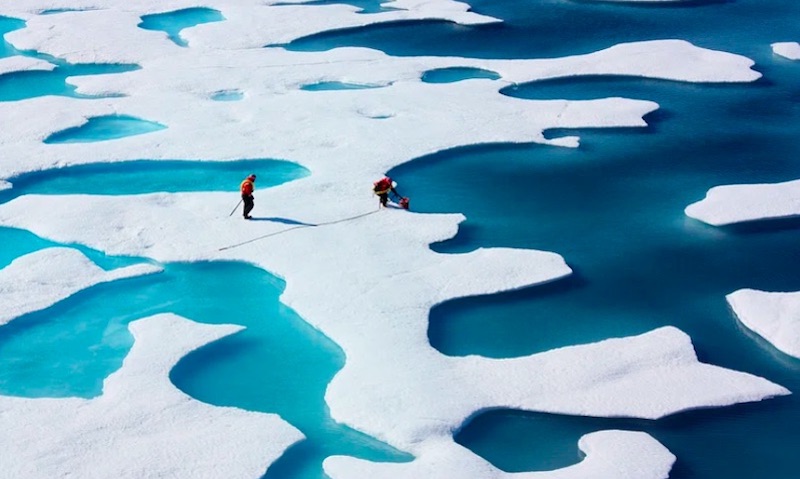The Arctic has always been one of the most remote and mysterious regions on Earth, captivating scientists, explorers, and environmentalists with its vast icy expanse and unique ecosystems. For centuries, this frozen landscape has served as an indicator of our planet’s health, reflecting climate changes more visibly than other parts of the world. However, what was once a place of observation and admiration has now become one of the greatest areas of concern for scientists and environmentalists. The acceleration of global warming has caused drastic changes in the Arctic, with consequences that extend beyond the region’s borders and can affect the entire planet.
In recent years, the Arctic has experienced extreme temperatures, with weather phenomena breaking historical records and threatening the region’s stability. February of a recent year saw temperatures rise by up to 10°C in some areas of the Arctic, surpassing historical averages and intensifying the climate crisis. These temperature increases are not isolated events but part of a broader trend that has triggered a series of catastrophic natural events, such as wildfires, floods, and the extreme reduction of sea ice coverage.

By the end of that February, the region recorded the lowest sea ice levels ever for that time of year, breaking the previous record from 2018. This was not an isolated incident: since 2020, the region has seen consecutive record-low sea ice levels, reflecting a downward spiral that has lasted for two decades. For scientists, this represents a growing warning that the Arctic is entering a new climate stage, where sea ice loss and extreme temperatures are no longer occasional events but constant phenomena.
Arctic sea ice, which typically peaks at the end of winter, has been shrinking alarmingly, with the past two decades witnessing the lowest ice coverage ever recorded. Experts warn that without significant changes in greenhouse gas emissions, the Arctic could face an ice-free summer by 2050, or even earlier in some of the more pessimistic scenarios. If the trend continues, the first ice-free summer could occur as early as the next decade.
The reduction of Arctic sea ice is not just a local concern. Sea ice plays a vital role in regulating global temperatures, acting as a “natural mirror” that reflects solar radiation back into space. When the ice melts, the much darker ocean water absorbs a greater amount of solar radiation, further accelerating global warming. This vicious cycle, in which ice melt contributes to rising ocean temperatures, is one of the main drivers of global warming in the region.
Moreover, the Arctic is warming four times faster than the rest of the planet. This phenomenon, known as “polar amplification,” is caused by the interaction between ice loss and atmospheric currents that generate even higher temperatures. During the winter of 2023, the extreme heat that hit the region was classified as one of the most intense ever recorded, with some estimates indicating it was one of the three strongest warming events since satellite measurements began in the 1970s.
The melting of permafrost, the frozen soil layer covering large areas of the Arctic, is also accelerating this process. As permafrost melts, vast amounts of carbon dioxide and methane – two potent greenhouse gases – are released into the atmosphere, further intensifying global warming. This process is further aggravated by the increased frequency and intensity of wildfires in the region, which have become more common due to rising temperatures and the greater availability of combustible material. These fires not only destroy vast areas of vegetation but also release large amounts of carbon into the atmosphere, exacerbating the global climate crisis.
The loss of sea ice and permafrost melting not only affect the global climate but also have a devastating impact on Arctic biodiversity. The local flora and fauna, which have evolved to thrive in low temperatures, are being forced to adapt to rapid and unpredictable changes. Species such as polar bears, seals, walruses, and various seabirds rely on sea ice for feeding, resting, and reproduction. With the diminishing ice, these species are being forced to migrate or adapt their behaviors to survive, often resulting in declining populations.
Furthermore, around 4 million people, mostly indigenous communities, live in the Arctic, many of whom directly depend on sea ice for survival, whether for hunting, fishing, or transporting goods. These populations face an uncertain future as ice loss and rising temperatures affect not only their way of life but also the natural resources they depend on. The loss of sea ice can disrupt transportation routes and reduce the availability of traditional foods, such as fish and marine mammals, threatening local cultures.
The impacts of Arctic melting are not confined to its icy regions; they have global repercussions. The melting of massive ice sheets, such as those in Greenland, is significantly contributing to rising sea levels. Greenland’s ice sheet currently loses about 280 billion tons of ice annually, accounting for a considerable portion of sea level rise. If this trend continues, rising sea levels could result in devastating flooding, affecting coastal cities and populations worldwide.
Additionally, Arctic warming directly impacts the jet stream, a high-altitude air current that influences weather patterns globally. The weakening and alteration of this stream are causing changes in global weather, such as more persistent heatwaves, prolonged cold spells, intense droughts, and stronger storms. These changes affect millions of people in various parts of the world, from North America and Europe to tropical and subtropical regions, where extreme weather events are becoming increasingly frequent.
Besides the climate and environmental challenges, geopolitical issues are also hindering the ability to monitor and understand what is happening in the Arctic. The war between Russia and Ukraine has resulted in the isolation of Russian scientists, who play a crucial role in Arctic research. The exclusion of these experts from international collaborations significantly hampers the monitoring and analysis of vital data on Arctic changes.
In the United States, the Trump administration’s policies, which led to significant cuts to government agencies that fund and conduct climate research, have alarmed the global scientific community. These cuts directly affected scientists’ ability to collect and analyze Arctic data, further complicating the understanding of the speed and magnitude of the changes occurring.
The future of the Arctic is uncertain, but one thing is clear: if current greenhouse gas emission trends continue, the region could be irreversibly altered within a few decades. The loss of Arctic ice not only changes the local landscape and biodiversity but also has a profound impact on all aspects of the global climate. The good news is that if we take immediate and significant action to reduce greenhouse gas emissions, some of these changes can be mitigated, although scientists warn that reversing them would take centuries.
The Arctic, once a symbol of purity and climate balance, now serves as a reflection of the rapid and profound changes we are causing on our planet. What happens in the Arctic is not just about the region but affects all of us. The Arctic crisis is, in fact, a warning to humanity that time is running out. If we fail to act now, the impact will not be just local but global, affecting future generations in ways we can barely imagine. The Arctic, therefore, demands our urgent attention – to protect the balance of the global climate and, ultimately, our own future.

